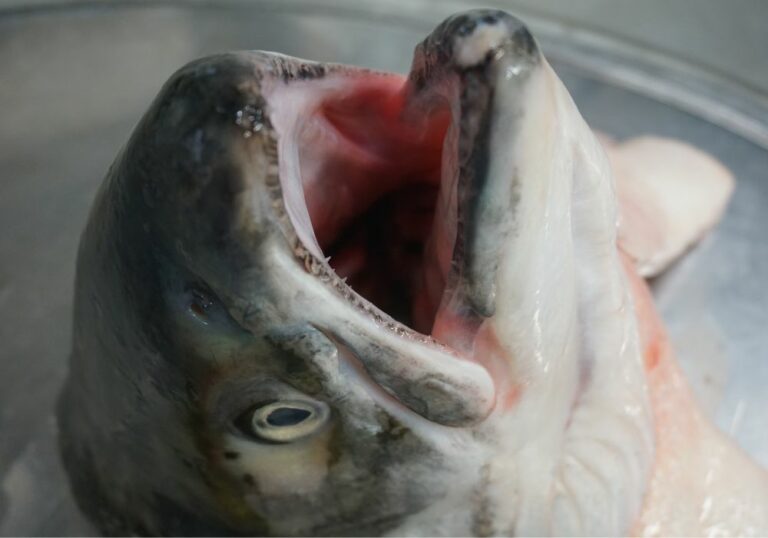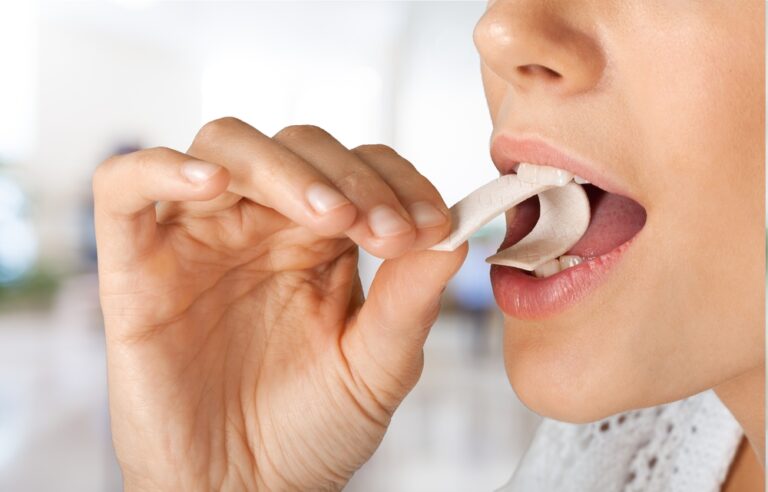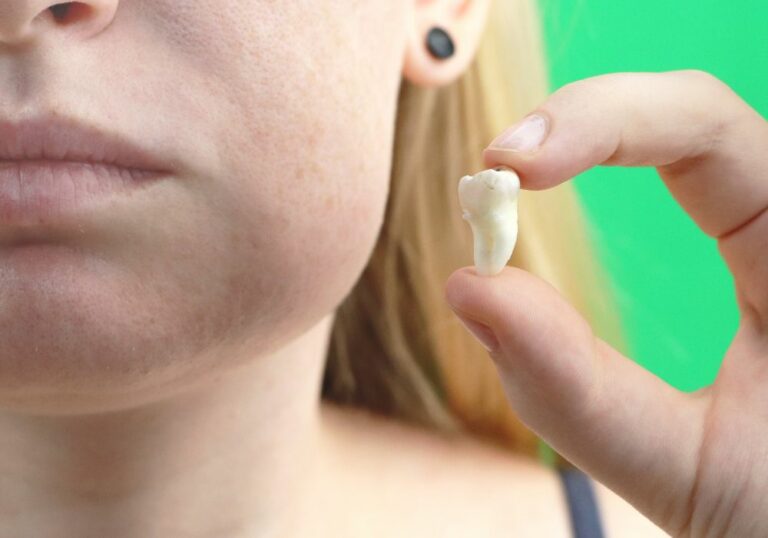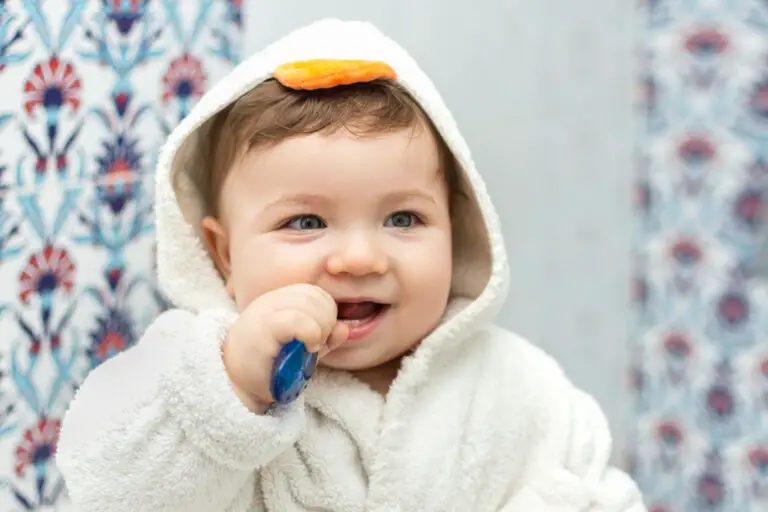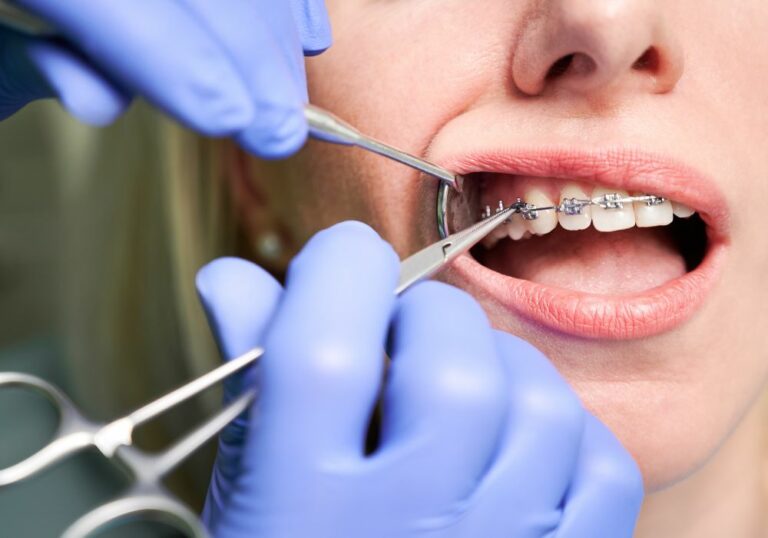Horses are herbivores, meaning they survive primarily on plant-based foods. As plant eaters, horses have evolved specialized teeth to help them chew and digest fibrous vegetation. A horse’s teeth are highly adapted for grazing and grinding tough grasses, hay, and grain. Let’s take a closer look at how and why horses’ teeth developed their unique structures and functions.
Horse Teeth 101
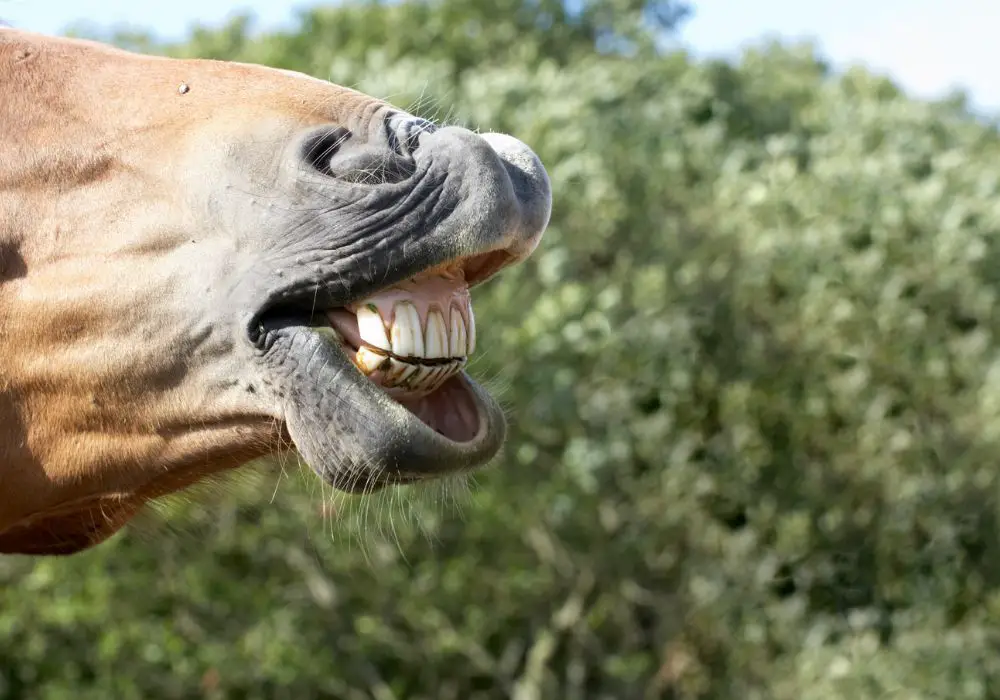
Horses have between 36 and 44 teeth, depending on their age and sex. Mares generally have 36-40 permanent teeth, while stallions have 40-44 permanent teeth.
A horse’s teeth include:
Incisors
- Located at the front of the mouth, incisors are used for biting off grass and other vegetation.
- Adult horses have 12 incisors (6 upper and 6 lower).
- Incisors are covered in enamel and have a flat chewing surface. They are ideally suited for clipping vegetation.
- The incisors are the front “nipping” teeth that cut off and collect grasses and hay.
- Horses use incisors to grasp, rip, and shear off plants and grass stems. The flat surfaces then crush and break down food.
- Incisors are shovel-shaped with a pronounced curve called the proper incisor curvature. This allows for efficient nipping of grass.
- The incisors show the most wear as they directly contact food during biting.
Canine Teeth
- Canine teeth sit just behind the incisors (one upper and lower on each side).
- In mares, canines may be underdeveloped or absent altogether.
- Stallions have pronounced, tusk-like canines used for biting and fighting.
- The sharp canine teeth may help stallions grip necks during fighting.
- Canines show little wear compared to other teeth.
Premolars & Molars
- Located further back along the dental arcade, premolars and molars grind food.
- Premolars and molars have ridged surfaces for crushing plant material.
- Most adult horses have between 20-24 cheek teeth made up of premolars and molars.
- Premolars and molars slowly erupt as horses age to replace deciduous cheek teeth.
- The upper and lower cheek teeth interlock to provide expanded grinding surfaces.
- Premolars have two cusps while molars have three cusps. The multiple cusps create a mortar and pestle grinding mechanism.
- The cheek teeth show more wear facets and cupping from grinding than incisors.
| Type of Teeth | Number in Adult Horse | Purpose |
|---|---|---|
| Incisors | 12 (6 upper, 6 lower) | Biting off vegetation |
| Canines | Up to 4 (2 upper, 2 lower) | Biting, defense (stallions) |
| Premolars | Up to 12 (6 upper, 6 lower) | Grinding food |
| Molars | Up to 12 (6 upper, 6 lower) | Grinding food |
Horses also have temporary teeth that fall out as adult teeth grow in. Young horses have:
- 12 to 24 temporary premolars
- 12 temporary molars
- These deciduous teeth are smaller and smoother than permanent teeth.
- Deciduous incisors and premolars are slowly replaced by bigger, permanent teeth.
- Temporary teeth help young horses chew and grind food as adults develop.
These specialized teeth allow horses to efficiently process large amounts of rough plant material daily. But why did horses evolve teeth structured this way?
The Evolution of Horse Teeth
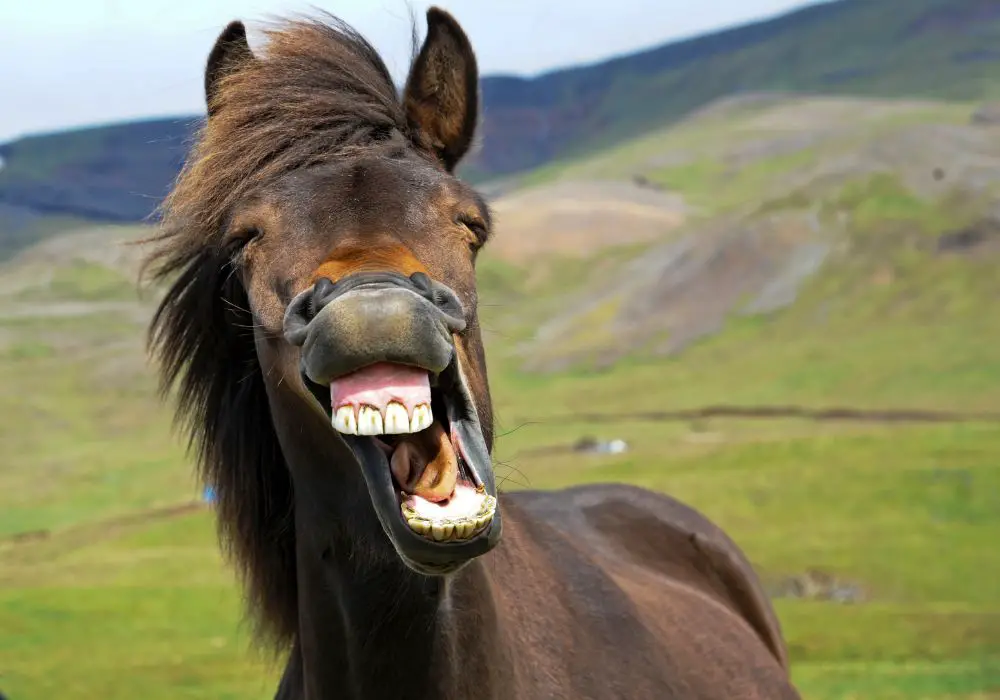
Horses belong to the order Perissodactyla, which includes other hoofed mammals like tapirs and rhinos. Approximately 55 million years ago, small perissodactyl ancestors of the modern horse lived in forests. These primitive equines likely ate a mix of leaves, fruits, twigs, and other soft vegetation.
Over millions of years, some perissodactyls adapted to life on open grasslands. Grasses provided abundant food but required more grinding to break down cellulose and extract nutrients. Early equine ancestors evolved larger, stronger teeth with ridges and complex enamel patterns. This gave them an evolutionary advantage on the grasslands.
Key evolutionary changes to horse teeth and diets include:
- Larger molars – Increased chewing surface area to process more grass. The molars broadened and expanded.
- Crescent-shaped ridges – Allowed for crushing food side-to-side. Curved ridges improved grinding efficiency.
- Cement – Coats the base of the teeth for protection against wear. Cementum prevents exposed dentin.
- Long tooth roots – Anchor teeth deeply for strength when chewing. Roots fused to the jaw bone for stability.
- Open pulp cavity – Creates space for secondary dentine to extend tooth life. Prevents pulp exposure when worn.
- Abrasion resistant enamel– Protects teeth from grass silica particles. Specialized enamel withstands attrition.
These adaptations took place over more than 50 million years across proto-horses like Eohippus, Mesohippus, and Miohippus. The incremental changes gradually optimized equine teeth for grazing tough grasses across different environments. Today’s horse teeth retain these same essential structures that evolved for grinding.
Horse Teeth Growth & Development
A horse’s specialized grinding teeth develop gradually over their lifetime. Here are some key facts about how a horse’s teeth grow and wear:
Deciduous Teeth
- Foals are born with no visible teeth. The deciduous teeth are buried in the gums.
- Milk or deciduous teeth begin to erupt through the gums around 8 – 10 days after birth.
- Tiny, sharp incisor caps appear first followed by front premolars.
- By 6 months old, foals have a full set of 24 deciduous teeth used for nursing.
- Deciduous teeth help foals transition from nursing to solid food.
- These temporary teeth are much smaller and smoother than permanent adult teeth.
Permanent Teeth
- Permanent incisors start coming in around 2.5 – 3 years old, replacing deciduous incisors.
- The permanent incisors are larger and stronger with pronounced roots and crowns.
- Maxillary (upper) incisors erupt first followed by mandibular (lower) incisors.
- The horse has a full set of permanent incisors around age 5.
- Premolars and molars slowly replace deciduous teeth from ~2.5-5 years old as the jaw lengthens.
- The last permanent premolars (wolf teeth) usually erupt around 4.5-5 years old.
- Young horses may have a combination of permanent and deciduous teeth as adult teeth grow in.
Tooth Growth & Wear
- Horses have open-rooted hypsodont teeth that continue growing throughout life.
- Cementum lays down new dentine in the reserve crown pulp cavity.
- Horses produce 1-2mm of new tooth annually but wear 2-3mm from grinding.
- Tooth growth slows starting around age 10-15 years. More dentine resorbs than deposits.
- By age 15-20, teeth erode faster than they grow, reducing grinding ability. Elderly horses have very worn teeth.
The dynamic growth of horses’ specialized teeth allows them to maintain the chewing surfaces needed to grind down tough vegetation. Their teeth form critical adaptations for a grazing, foraging lifestyle.
Unique Structures of Horse Teeth
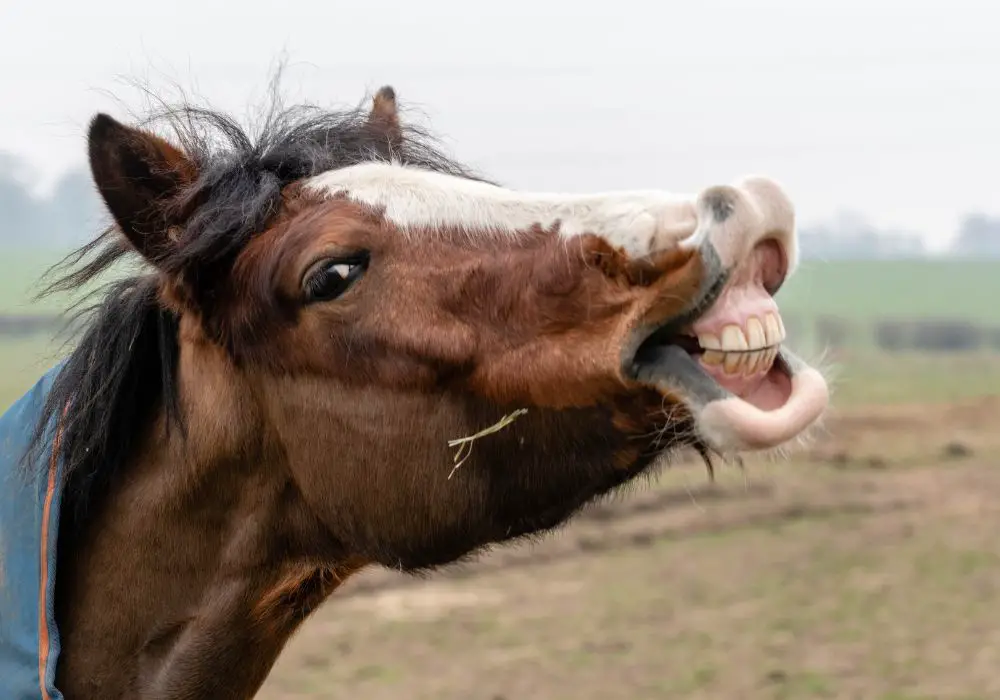
Several specialized structures equip horses’ teeth for efficiently chewing large volumes of grass and hay:
Dental Arcades
- The aligned upper and lower teeth create end-to-end ridges that function like mortar and pestle.
- The opposing arcades provide expanded grinding surfaces and efficiency.
- Arcades may also include diastemata or vacant spaces between some teeth. This allows specific teeth to accept force during chewing.
Infundibulum
- The central folding or fissure of enamel strengthens and increases surface area.
- It also assists in grinding and promotes even wear resistance.
- Food can become impacted in the infundibula but is often cleared by chewing and saliva.
Triadan Cusps
- Premolars and molars (cheek teeth) have rows of cusps.
- Mandibular (lower) molars have three distinctive cusps – anterior, middle, posterior.
- The multiple cusps provide additional surfaces for chewing side-to-side and crushing.
Cementum
- Cementum coats the tooth where it meets the gums and jaw, protecting the root from damage.
- Cementum is softer than enamel and wears faster from chewing. It continually deposits to make teeth longer.
Secondary Dentine
- The open pulp cavity allows secondary dentine to fill space worn away by chewing.
- Secondary dentine compensates for the daily wear of primary dentine and enamel.
- Adds length to counteract chewing forces constantly eroding crown away.
Together, these specialized structures maximize grinding capacity and tooth longevity – essential adaptations for grazing horses.
Impacts of Diet on Equine Teeth
A horse’s natural diet consists of grazing on pasture grasses or eating dried hay. Their teeth evolved for coarsely grinding such foods. However, modern management practices and supplemental feeding can affect horses’ oral health.
Chewing abrasive, fibrous foods helps wear teeth evenly. Diets too high in finely processed grains and lacking sufficient roughage can allow uneven wear and sharp enamel points. This may require floating (filing down points) to prevent cheek injuries.
Likewise, feeding only rich hay and grass may not provide enough abrasion for ideal wear. Uneven wear can still occur without coarse silica dust from dry pasture vegetation. Dental exams help identify problems like overgrowths, hooks, ramps, and wave mouth early.
Ensuring a balanced, natural diet optimizes wear and overall tooth health. Allowing horses to graze builds muscles for proper chewing. This reduces tooth decay risks and periodontal issues due to underuse. With proper nutrition and wear, horses can maximize the grinding function of their specialized grazing teeth.
Frequently Asked Questions
How many teeth do horses have?
Adult horses have between 36-44 permanent teeth. This includes 12 incisors, up to 4 canines, and 20-28 premolars and molars. Young horses also have 24 deciduous or baby teeth that sequentially fall out as permanent adult teeth erupt.
At what age do horses get their permanent teeth?
Horses begin tooth replacement around age 2.5-3 as permanent incisors start coming in to replace deciduous incisors. The horse has all its permanent incisors fully erupted by age 5. Premolars and molars slowly replace baby teeth sequentially from age 2.5-5 years old as the jaw lengthens and grows.
Do horses’ teeth keep growing?
Yes, horses have specialized hypsodont teeth that continuously grow and erupt throughout their lives. The pulp cavity stays open to allow secondary dentine to extend tooth length as chewing grinds down and erodes the primary dentine. Horses produce 1-2mm of new dentine annually.
What is “floating” a horse’s teeth?
Floating is filing or rasping down sharp enamel points and any uneven wear to create a smooth chewing surface. Floating removes hooks, ramps, and overgrowths that can injure the horse’s mouth or lead to abnormalities. Dentists float teeth using specialized power rasps and hand tools.
When do horses need dental exams and care?
Horses should have routine dental exams starting from an early age to evaluate tooth growth and wear. Dental checks help identify issues needing correction like retained caps or wave mouth. Adult horses need exams at least yearly. Older horses likely require biannual dental care as tooth growth slows but chewing needs persist.
Conclusion
In summary, the unique anatomy and physiology of horses’ teeth evolved to make them effective grazers able to grind down and digest fibrous grasses, hay, and vegetation. Key evolutionary adaptations include cement-coated hypsodont teeth that continually erupt and specialized chewing surfaces. Together, these traits equip horses with durable grinding and shearing teeth that self-adjust to the demands of their roughage diet and lifestyle. With proper care and nutrition to optimize dental function, horses can thrive and maximize the performance of their natural grazing teeth.

